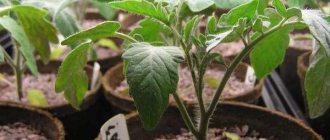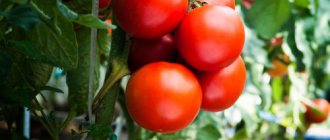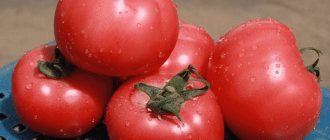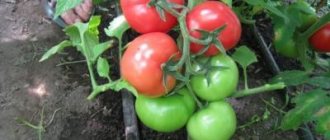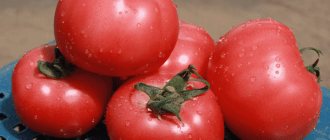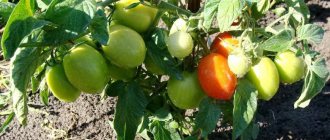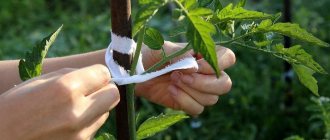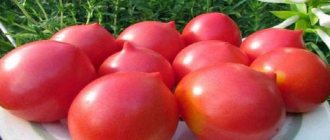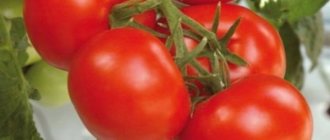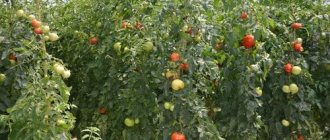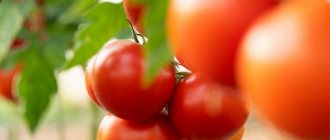The Raja tomato is suitable for summer residents who want to get a tasty harvest as early as possible. Tomatoes grow well in open ground, ripen quickly and taste great.
| Height | Landing location | Ripening time | Fruit color | Fruit size | Origin | Fruit shape |
| Medium height | Greenhouse, Open ground | Early ripening | Reds | Large | Variety | Plum-shaped or oval |
Description and characteristics of the variety
Tomatoes ripen 80–95 days after planting the seedlings. A powerful, strong bush grows up to 1-1.5 meters in height. Due to their large growth, the plants require mandatory staking. One bush can produce up to 3-4 kg of tomatoes. For 1 sq. 2-3 plants are planted per meter; the branches of the bushes are quite spreading. The yield is 8–9 kg per square. In August, tomatoes ripen and harvesting begins.
The large fruits are elongated and plum-shaped. The weight of one copy is 200-300 grams. After ripening, tomatoes turn bright red. Fleshy pulp with silvery grains on the cut, almost without seeds, tastes sweet. One bunch contains 5-7 fruits.
Promising tomato variety Raja - description, features of planting, care and cultivation
Tomatoes are one of those vegetables that are constantly present in our diet. We eat them fresh, marinate and salt them, add them to salads, borscht and sauces.
This vegetable contains a huge amount of various vitamins and microelements, including serotonin, which is called the hormone of joy. If you prefer new varieties of tomatoes, then you should pay attention to Raja tomatoes.
Characteristics of Raja variety tomatoes
Dark red tomatoes of the Raja variety with a remarkable oval shape meet all the criteria for tasty tomatoes: they are fleshy, have a thin skin, tender flesh with starchy silvery inclusions on the cut, a sweetish taste, and a characteristic tomato smell.
Ripening of beautiful tomatoes (photo)
Other advantages of the variety, according to reviews, are:
- early ripeness. The fruits begin to ripen at the end of July, and by the end of August the fruiting process ends;
- large-fruited. The weight of one fruit is 250-300 g;
- high yield. With proper care, you can harvest up to 8 kg of tomatoes from one square meter;
- the possibility of growing not only in a greenhouse, but also in open ground;
- semi-determinate (medium height). The bush grows up to 1 meter in height. This allows for economical use of planting space and makes it easier to care for the crop.
Raja variety tomatoes can be grown both for fresh consumption and used for processing
Features of growing Raja tomatoes
In principle, caring for Raja tomatoes does not differ significantly from caring for other varieties of tomatoes, but still has its own specifics.
Sowing and caring for seedlings
The Raja tomato variety requires cultivation through seedlings. Sowing is carried out 2 months before planting seedlings in open ground. After the formation of two true leaves, the seedlings are planted in separate containers.
Before planting in the ground, seedlings should be strong with 7-9 true leaves of dark green color. If inflorescences appear on the seedlings, it is better to remove them. 7 days before planting, it is recommended to feed the plantings with complex mineral fertilizers, in which potassium and phosphorus predominate.
Seedlings are planted in open ground in the absence of return frosts and after the soil has warmed up to +15 degrees. Planting rate is 2-3 bushes per square meter. meter
Optimal temperature conditions for Raja tomatoes
Temperature conditions are very important for tomatoes, especially when grown in a greenhouse. The optimal temperature for this variety is +23-25 during the day and not lower than +15 at night. Higher daytime temperatures and lower night temperatures can negatively affect the plant and lead to the bush becoming topped (stops growing upward).
Watering rules
The variety requires regular watering. The signal for its necessity is the drying of the top layer of soil. Watering is carried out 2 times a week, abundantly, so as to saturate the soil to at least 15 cm.
The fruits of beautiful tomatoes (photo)
Watering should be carried out only at the root, without using sprinklers. Otherwise, you can provoke the spread of fungal diseases, as water will fall on the stems and leaves of the plant.
During the ripening period of the variety, watering can be carried out more often, without allowing the soil to become waterlogged. The optimal humidity when growing varieties in a greenhouse is from 50 to 60%.
Stepping and bush formation
The Raja variety bush is best formed into two stems. The stepson located under the first inflorescence is chosen as a side stem. Up to 5 brushes are left on the main stem, 3-4 on the lateral stem. After their formation, it is recommended to pinch the top of the plant.
Thinning of clusters helps the development of large fruits. 3-4 fruits are left on the lower inflorescences, 6-8 on the others. Defective ovaries should be removed.
Without timely pinching, it is impossible to get an early harvest. Excess shoots are removed when they reach a length of 5-6 cm. This must be done every week. Removing larger stepsons can result in damage to the stem.
Many gardeners believe that as soon as tomatoes enter the fruiting period, all foliage from the plant must be removed.
This is the wrong decision, since the bush will begin to spend all its energy on restoring green mass, and the fruits will receive less nutrients.
It is recommended to remove those leaves from the tomato that are in contact with the ground and with each other. This procedure is a preventive measure against late blight infection; it is necessary to provide the fruits with high-quality sunlight.
Features of feeding Raja tomatoes
Growing tomatoes in a greenhouse (photo)
The semi-determinate variety Raja will certainly please its owners with a rich early harvest. You should know that tomato tends to form a large number of fruits due to the defective development of the above-ground part and root system.
If, with a large number of ovaries, the plant lacks minerals, then the apical part of the bush may stop growing. To avoid this, Raja tomatoes must be fed in a timely manner.
During the flowering period, the plant especially needs phosphorus; during fruiting and ripening, the crop needs potassium.
Tomatoes of the Raja variety clearly signal by their appearance which elements they lack and which are present in excess:
- With a lack of nitrogen, the tomato bush grows slowly, withers, and has pale, small leaves. The veins on the underside of the leaf become reddish with a blue tint;
- A lack of phosphorus is indicated by a purple tint of leaves and stems;
- Potassium deficiency is indicated by young leaves curled into a tube, as well as a yellow-brown border along the edges of the leaves;
- with an excess of nitrogen, the green mass of the above-ground part of the plant fattens, but there are few flowers and ovaries on the bush;
- excess phosphorus leads to yellowing and falling of tomato leaves and ovaries;
- Excess potassium is indicated by dull spots on the leaves of the plant.
The best option for nitrogen fertilizers for Raja tomatoes is the application of infusions of manure, chicken droppings, and nettles.
Carrying out root and foliar fertilizing with ash will provide tomatoes with potassium and phosphorus. When using mineral fertilizers, the main emphasis should be on complexes that contain several elements necessary for the plant.
While watching the video you will learn about tomato varieties.
The Russian tomato variety Raja is grown in greenhouses and in open ground. Without film, it can be planted even in the northern regions of the country. Breeders have tried to develop a variety of tomatoes not only with excellent taste, but also with early fruit ripening.
Description and characteristics of the variety
Tomatoes ripen 80–95 days after planting the seedlings. A powerful, strong bush grows up to 1-1.5 meters in height. Due to their large growth, the plants require mandatory staking. One bush can produce up to 3-4 kg of tomatoes. For 1 sq. 2-3 plants are planted per meter; the branches of the bushes are quite spreading. The yield is 8–9 kg per square. In August, tomatoes ripen and harvesting begins.
The large fruits are elongated and plum-shaped. The weight of one copy is 200-300 grams. After ripening, tomatoes turn bright red. Fleshy pulp with silvery grains on the cut, almost without seeds, tastes sweet. One bunch contains 5-7 fruits.
Purpose of the Raja variety
Raja tomatoes have high taste, they are consumed fresh, prepared in salads, made into ketchups, sauces, purees and juices. Despite their large size, tomatoes are canned for the winter.
Advantages and disadvantages of tomatoes
This variety has many advantages:
- excellent taste;
- early fruit ripening;
- high productivity;
- the fruits do not crack;
- possibility of growing in open soil;
- average transportability;
- Tomatoes are resistant to various diseases.
The variety has practically no disadvantages. During seedling growth, pinching and pinching are necessary. Mandatory staking of bushes is required; the tomato harvest depends on this.
Features of growing the variety
Seeds are sown in March in seedling containers with a pre-prepared earth mixture: turf soil, humus, sand (2:2:1). The sown seeds are sprinkled with soil on top and watered. The container can be covered with film material. The air temperature for germination is approximately 18-20 degrees Celsius. When the first shoots appear, the film is removed.
Strong seedlings (with a couple of leaves) are transplanted into individual pots. After picking, stimulants are added to the soil for better root development and faster rooting. 7-10 days before transplanting into open ground, seedlings are fed with complex fertilizers. Seedlings need to be hardened off by taking them outside for a couple of hours a day.
About two months after sowing, the seedlings will have 7-8 leaves and can already be transplanted into open soil. In May, the earth will warm up enough and the seedlings will quickly sprout.
I add humus, peat, sand to the holes, mix it all with the ground. Plants are planted 30-40 cm apart, with an interval of 60 cm between rows.
Features of care
- The optimal temperature for bush growth is 22-25 degrees Celsius. At night it should not fall below 15 degrees. Low or very high temperatures can cause plants to topple.
- Abundant watering is required 2 times a week, the soil should be well saturated with moisture. Water only at the roots so that water does not get on the leaves.
- Two stems are left on one plant. Leave a side branch under the first inflorescence. There are 5 tassels on the main stem, and 4 tassels on the lateral stem. The crown of the plant is pinched.
- Tie the branches to a trellis or stakes. The first garter occurs a couple of weeks after planting the seedlings. New loops are made as the bush grows, but at least once every two weeks.
- In order for large fruits to develop better, you need to thin out the clusters and do not forget to remove defective ovaries.
- During the growth of bushes, plants are fed with fertilizers containing nitrogen: manure, chicken droppings, nettles. During the flowering period, phosphorus fertilizers are needed, and during the development of fruits, potassium fertilizers are needed. Calcium nitrate is added a couple of times per season.
Important
! If there is a lack of nitrogen, the plant stops growing. And an excess of nitrogen supplements leads to a small number of ovaries.
In which regions of the country are tomatoes grown?
Due to its short ripening period and its characteristic characteristics, the Raja variety can be cultivated in all regions of the country. In the northern and northwestern regions of the Russian Federation, tomatoes can be grown in open ground. Having planted seedlings in May, the harvest is harvested in August.
Diseases and pests
Raja is resistant to viruses and fungi and does not require preventive treatment with fungicides. But, nevertheless, late blight in rare cases can damage plants. If you do not follow the watering rules, fungus may appear on the bushes. Therefore, water should not be directed to the stems and foliage, but should only be poured at the root.
Reviews
I have been planting Raja tomatoes for the second year now. The tomatoes are large, fleshy and sweet. The harvest turned out good, I closed the tomatoes for the winter.
In 2021, the Raja variety was grown in a greenhouse. The fruits ripened surprisingly quickly and early. The harvest turned out great, the tomatoes were sweet and tasty, I love meaty tomatoes. I tied up the bushes, they grew more than a meter high. I didn’t pinch the crown, but there were a lot of ovaries and brushes. I will plant tomatoes this year too.
A wonderful variety, I grew it without much experience. Large and fleshy tomatoes with a sweet flavor. The family was pleased. I wanted to collect my own seeds, but there are very few of them, the tomatoes are practically without seeds. The tomatoes ripened at the end of August, we collected them until the end of September. I had to tinker with tying up the bushes.
Advantages and disadvantages of tomatoes
This variety has many advantages:
- excellent taste;
- early fruit ripening;
- high productivity;
- the fruits do not crack;
- possibility of growing in open soil;
- average transportability;
- Tomatoes are resistant to various diseases.
The variety has practically no disadvantages. During seedling growth, pinching and pinching are necessary. Mandatory staking of bushes is required; the tomato harvest depends on this.
Characteristics and description of tomato "Raja"
“Raja” tomatoes are a variety that can be grown not only in open spaces, but also in northern conditions. Translated into English, the variety reads “rajah” and is a red semi-determinate bush of Russian selection.
In the article you will learn about detailed characteristics, cultivation and care, and other interesting facts about tomato bushes.
Description and characteristics of the variety
Tomatoes "Raja" are considered a large-fruited, early-ripening variety. The vegetables take on an oval shape, similar to the largest plums. The color is dark red, and the weight can reach up to 300 grams of each fruit. The pulp is very sweet, fleshy, tender, and does not have many seeds. The skin is quite thin, smooth surface. Inside, when cut, you can see grains similar to silver starch.
Tomato bushes begin to ripen at the end of the month of July, and by mid-August fruiting comes to an end. The productivity is high, since from 1 square meter, if you provide the plants with proper and careful care, it is possible to harvest approximately 7-8 kilograms of tomatoes.
The bushes can reach one meter in height. Thanks to this, gardeners can effectively use the planting space, which will make future maintenance easier. During flowering, the foliage acquires a dark green color, the stems become dense.
Advantages and disadvantages of the variety
“Raja” tomatoes are tomatoes that have excellent characteristics (medium size, large fruit, flowering in open soil and in greenhouse conditions, etc.), and they have even more advantages. Among them:
- Early fruit ripening.
- Excellent and beautiful presentation.
- Excellent taste and nutritional qualities.
- High yield.
- Resistance to a large number of diseases.
- Long-term storage of vegetables after harvesting at a temperature of 10-15 degrees Celsius.
- Good transportability over long distances.
One of the small disadvantages is that the soil will require fertilizing. To prevent plants from getting sick, and to prevent any pests and insects from harming them, the soil should be fertilized with minerals, and this will require financial costs.
Growing and care
Experienced breeders recommend growing Raja tomatoes using the usual, that is, classical method. Seeds should be sown in containers or boxes with the addition of peat mass. This is done 55-60 days before you transplant the sprouts to a permanent location. And as soon as the first few leaves appear, you should pick them into separate containers.
It is necessary to plant seeds in a permanent place in the ground depending on weather conditions, and better when the threat of frost has 100 percent passed. After picking and planting, it is necessary to water the seedlings and add stimulants to them for root formation.
Thanks to this bait, “Raja” tomatoes will quickly take root in the soil, the root system will actively develop and powerful stems will form. And this, in turn, will contribute to obtaining maximum yield.
Gardeners recommend using a special planting scheme - 60 by 40 centimeters. If you plant more plants per 1 square meter, you simply will not be able to walk between the beds. Watering should only be done in the evenings, namely two or three hours before the sun sets. At the same time, keep in mind that there is no excess moisture, but drying out of the soil is also unacceptable.
Tomato bushes need to be formed with 2 stems each. And as soon as 5-7 bunches of fruit appear, you will need to pinch the tops. It is better to make garters to special, pre-prepared posts - powerful stakes. Fixing with new loops must be done at least once a week, otherwise the tomatoes will simply “lie” on the surface of the soil.
The main thing is not to forget about the rules of watering during cultivation: it must be carried out twice in 7 days during severe drought. Experienced breeders recommend saturating the soil with moisture only at the roots and there is no need to use sprinklers, otherwise there is a high probability that the plants will develop fungal diseases. If cultivation occurs in greenhouse conditions, then optimal humidity must be maintained - from 50 to 60 percent.
Reviews from those who planted
Anna, 32 years old: “I have been gardening since early childhood and growing the Raja variety of tomatoes.” I recommend planting the seedlings in a permanent location as soon as the threat of frost has passed. I form the stems in half, and to ensure a full harvest, I leave only 4-5 brushes. I pinch the tops of the bushes so they don't fall to the ground. I get a full harvest by the end of August. At the same time, I grow it using the seedling method. First, I grow seedlings in boxes in special soil. I take turf soil, humus, sand. I keep the temperature at least 16 degrees Celsius. As soon as the bushes form foliage, I plant the stems in pots with a diameter of 10 centimeters. I fertilize with mineral fertilizers containing potassium and phosphorus.”
Kira, 39 years old: “I just recently started growing the Raja variety and am very pleased. The most important thing when growing is to follow the feeding schedule for tomatoes. I use ready-made fertilizers and mixtures. During the growth period, I add mineral fertilizers containing nitrogen, and as soon as the bushes begin to bloom, fertilizers that predominantly contain phosphorus. And if the fruits begin to actively develop, then use fertilizers containing more potassium. If there is not enough potassium, this may affect the ripening time and quality of tomatoes. If this happens, then add calcium nitrate and do not mix with any other products. Don’t forget about foliar fertilizing with fertilizers containing boron, manganese, magnesium and iron.”
Features of growing the variety
Seeds are sown in March in seedling containers with a pre-prepared earth mixture: turf soil, humus, sand (2:2:1). The sown seeds are sprinkled with soil on top and watered. The container can be covered with film material. The air temperature for germination is approximately 18-20 degrees Celsius. When the first shoots appear, the film is removed.
Strong seedlings (with a couple of leaves) are transplanted into individual pots. After picking, stimulants are added to the soil for better root development and faster rooting. 7-10 days before transplanting into open ground, seedlings are fed with complex fertilizers. Seedlings need to be hardened off by taking them outside for a couple of hours a day.
About two months after sowing, the seedlings will have 7-8 leaves and can already be transplanted into open soil. In May, the earth will warm up enough and the seedlings will quickly sprout.
Attention
! When transplanting into the garden, the first inflorescences on the seedlings are removed.
I add humus, peat, sand to the holes, mix it all with the ground. Plants are planted 30-40 cm apart, with an interval of 60 cm between rows.
Important
! It is not advisable to plant more than three bushes per square meter, as this may affect the future harvest.
You may be interested in: Dates for planting tomato seedlings in open ground and greenhouses according to the garden calendar Favorable days for planting tomatoes for seedlings in 2021 according to the lunar sowing calendar Favorable days for picking tomatoes in 2021 after germination: timing of picking tomato seedlings in the table by day
Growing seedlings
Tomato Raja is recommended to be grown in seedlings. In the south of the country it is possible to sow seeds directly into the ground. Preparatory work for sowing can begin in early February. Soil collected from the site must be disinfected in advance. There are several effective ways to do this (freezing, treating with boiling water, watering with a solution of potassium permanganate). Soil purchased in a store is suitable for sowing without disinfection.
Related article:
How to grow large tomatoes
Proper seed preparation significantly increases yield. Experienced vegetable growers process seeds according to the following algorithm:
- first warm up at a temperature of 55-60 C for 2 hours;
- Dip the seeds (in a gauze bag) into boiling water for 1-2 seconds, and then cool in cold water (for disinfection);
- after heat treatment, keep in formaldehyde for 2-3 minutes;
- soak for 6-8 hours in a growth stimulator.
The sowing time is determined individually, depending on the growing region. But the guideline for all climatic zones is the same - sowing is carried out 60 days before planting the seedlings in the ground. During the development phase of the second true leaf, the seedlings dive. In order not to damage the fragile root system of the seedlings, it is better to use a syringe or a teaspoon for watering at first. You need to choose the brightest and warmest place for tomatoes. Phytolamps will help solve the problem of short days; they need to be turned on so that daylight hours last at least 10-12 hours.
Related article:
Calendar for planting tomatoes for seedlings 2021. Favorable days in February and March
Agrotechnicians recommend feeding seedlings according to the following scheme:
- a week after germination, pour in a solution of ammonia (1 tablespoon of alcohol per 1 liter of water);
- after picking, feed with infusion of ash (1 tbsp. spoon of ash per 1 liter of water and let it brew for 10 hours);
- every 10 days you can water it with a solution of hydrogen peroxide (1 tsp per 1 liter of water).
You can change the feeding scheme based on the appearance of the plants. So, if the bushes begin to outgrow, you can stop their growth with the drug Atlet.
Features of care
- The optimal temperature for bush growth is 22-25 degrees Celsius. At night it should not fall below 15 degrees. Low or very high temperatures can cause plants to topple.
- Abundant watering is required 2 times a week, the soil should be well saturated with moisture. Water only at the roots so that water does not get on the leaves.
- Two stems are left on one plant. Leave a side branch under the first inflorescence. There are 5 tassels on the main stem, and 4 tassels on the lateral stem. The crown of the plant is pinched.
- Tie the branches to a trellis or stakes. The first garter occurs a couple of weeks after planting the seedlings. New loops are made as the bush grows, but at least once every two weeks.
- In order for large fruits to develop better, you need to thin out the clusters and do not forget to remove defective ovaries.
- During the growth of bushes, plants are fed with fertilizers containing nitrogen: manure, chicken droppings, nettles. During the flowering period, phosphorus fertilizers are needed, and during the development of fruits, potassium fertilizers are needed. Calcium nitrate is added a couple of times per season.
Attention
! Excess shoots are pruned when they grow no more than 6 cm in length; removing longer branches can damage the main stem.
Important
! If there is a lack of nitrogen, the plant stops growing. And an excess of nitrogen supplements leads to a small number of ovaries.
Transplantation into soil and care
When the threat of return frost has passed, the seedlings are moved to the ground or greenhouse. In the northern regions, it is recommended to build a temporary shelter for the beds until warm weather sets in. Plants take root faster if you add humus or a handful of complex fertilizer to the planting hole.
Related article:
Once you cut it, you collect three times as much!
As it grows, it is necessary to remove excess side shoots and tie up the bush. To increase productivity, the crown can be formed into two stems. To do this, you need to leave the first, strongest stepson, located between the stem and the bottom leaf, to grow.
In order to collect large fruits and not delay their ripening, you should leave no more than 4-5 clusters on the bush and pinch the top after they form. Fruits do not ripen evenly within the same cluster. Therefore, the yield of the harvest is extended over time. Since the variety is not of the pickling type, this feature is often considered an advantage.
The beds should be watered rarely (once every 10 days), but abundantly. During fruiting, the soil should not be allowed to dry out, as this may cause the fruit to crack during subsequent watering. The next day after irrigation, it is important to loosen the soil near the bushes. It is recommended to mulch beds with straw only in hot summers; in cool weather this increases the risk of the spread of pests and diseases.
Related article:
The most common red varieties of tomatoes
Raja is resistant to diseases characteristic of nightshades and rarely gets sick. But in rainy and cool summers, when late blight develops rapidly, prevention will not be superfluous.
Treatment with an environmentally friendly solution of milk and iodine (1 liter of milk, 15 drops of iodine, 10 liters of water) will save tomatoes from late blight. You can spray the bushes with milk all season, with an interval of 10-12 days.
